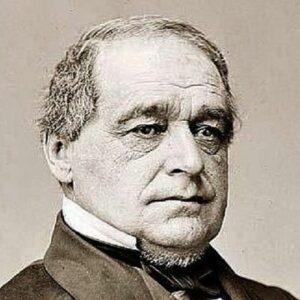Hannibal Hamlin served as the fifteenth Vice President of the United States from 1861 to 1865 during President Abraham Lincoln’s Republican administration. Hamalin was born to a farmer and worked on his family farm for a time after graduating from Hebron Academy. He later managed a weekly newspaper. He then studied law and, following the establishment of his legal practice, entered politics as an anti-slavery Democrat, serving in the Maine state legislature. He was later elected to the United States House of Representatives and later to the Senate. During his first term as a senator, he took a pro-slavery stance on sectional issues and later defected from the Democratic Party in 1854 over the party’s endorsement of the Kansas-Nebraska Act. Following that, he joined the Republican Party and was elected governor of Maine, but resigned after only a few months, returning to the Senate for the second time. Hamlin was nominated for Vice President by the Republican National Convention of 1860 and was duly elected during Abraham Lincoln’s administration. Hamlin served as Vice President of the United States from 1861 to 1865, during the Civil War, advocating for emancipation and the arming of freedmen. He was then re-elected to the Senate and served two additional six-year terms. He was later appointed a diplomat, and after a year as Minister to Spain, Hamlin stepped down from politics and returned to his Maine home, where he died at the age of 81.
Childhood & Adolescence
Hannibal Hamlin was born in Paris Hill, Maine, on August 27, 1809, to Cyrus Hamlin, a farmer and surveyor, and Anna Livermore, his wife.
Hamlin received his early education in district schools and then attended Hebron Academy, a Hebron, Maine-based preparatory school. Following that, he managed his family farm for a time and later worked as a teacher and editor of a weekly newspaper.
Then, under the tutelage of Samuel Fessenden, he studied law and was admitted to the bar in 1833.
He later established his own law practice and earned a reputation as a competent attorney.
Career of Hannibal Hamlin
Hamlin began his political career in 1835 as an anti-slavery Democrat and was elected to the Maine House of Representatives, where he served with the militia during the 1839 Aroostook War. He aided in de-escalating tensions and paved the way for the Webster-Ashburton Treaty, which ultimately brought the war to an end.
He left the State House in 1841 after an unsuccessful run for the United States House of Representatives in 1840. In 1843, he was appointed to the United States House of Representatives from Maine’s 6th congressional district, a position he held until 1847. He chaired the Elections Committee.
In 1848, he was elected to fill a vacancy in the United States Senate, a position he held until 1857.
Since the beginning of his tenure in Congress, Hamlin has been a staunch opponent of slavery expansion. He argued vehemently against the Kansas-Nebraska Act, which repealed the Missouri Compromise, in 1854.
Subsequently, at the 1856 Democratic National Convention, the Democratic Party permitted that repeal. Dissatisfied with his party’s stance on slavery, Hamlin defected to the newly organized Republican Party.
He was elected the first Republican Governor of Maine in 1856 and took office in January 1857. He served as governor for a brief period and resigned in late February, preferring to resume his Senate seat. He returned to the United States Senate from 1857 to 1861.
Hamlin was nominated for vice president by the Republican Party in 1860, with Abraham Lincoln as the presidential candidate. They won the election and Hamlin was elected Vice President of the United States in March 1861.
During the Civil War, from 1861 to 1865, Hamlin served as Vice President and one of President Abraham Lincoln’s chief advisers. While in office, Hamlin pushed for the Emancipation Proclamation and the arming of African-Americans, both of which Lincoln later adopted.
Andrew Johnson became President following Lincoln’s assassination in 1865 and appointed Hamlin Collector of the Port of Boston. However, the two had significant ideological differences, which ultimately led Hamlin to resign in protest of Johnson’s Reconstruction policy.
Hamlin was re-elected to the United States Senate in 1869 and served for an additional two six-year terms until 1880. He chaired a number of committees during his tenure, including the Committee on Mines and Mining and the Committee on Foreign Relations.
He was appointed United States Ambassador to Spain in 1881, a position he held until October 1882. He left politics after serving as a diplomat.
Significant Works of Hannibal Hamlin
Since his early career, Hamlin has been an outspoken opponent of slavery, rising to the position of United States senator and speaking out against the practice. As Vice President under Abraham Lincoln, Hamlin pressed Lincoln to issue the Emancipation Proclamation, which ended southern slavery, and later backed Radical Reconstruction.
Personal History and Legacies
Hamlin married Sarah Jane Emery in 1833 and together they had four children: George, Charles, Cyrus, and Sarah. Regrettably, Sarah passed away in 1855.
In 1856, he married Ellen Vesta Emery, Sarah’s half-sister. They had two sons, Hannibal E. and Frank.
Hamlin returned to his home in Bangor, Maine, after retiring from politics, where he died on July 4, 1891, at the age of 81. He was laid to rest in the Hamlin family plot at Bangor, Maine’s Mount Hope Cemetery.
Estimated Net Worth
Hannibal is one of the wealthiest politicians and is ranked among the most popular. Hannibal Hamlin’s net worth is estimated to be around $1.7 million, based on our analysis of Wikipedia, Forbes, and Business Insider.


